- MOE
- National Parks of Japan
- Fuji-Hakone-Izu National Park
- Characteristics
main body

Characteristics
Volcanoes Stretching from the Pacific Ocean to Sacred Mt. Fuji: Diverse Landscapes Created by Volcano Topography and Culture
Date of Designation: February 1, 1936, as Fuji-Hakone National Park (the Izu Peninsula area was incorporated and the name of the park changed on March 15, 1955; the Izu Islands area was incorporated on July 7, 1964)
Area: 121,695 ha (land area)
Related Prefectures: Tokyo, Kanagawa, Yamanashi, Shizuoka
Area: 121,695 ha (land area)
Related Prefectures: Tokyo, Kanagawa, Yamanashi, Shizuoka
Mt. Fuji is not simply Japan's highest mountain; it is a famous peak that is deeply rooted in the hearts of Japanese people and well-known throughout the world as a symbol of Japan.
With Mt. Fuji located at its northern end, Fuji-Hakone-Izu National Park is a national park representative of Japan--a volcanic country--comprising various volcanic landforms within the Fuji Volcanic Zone as well as hot springs, richly varying coastlines, and islands.
Fuji-Hakone-Izu National Park is divided into four areas: the Mt. Fuji Area, which is centered on Mt. Fuji and includes lakes, swamps, and plateaus in the surrounding area; the Hakone Area, which served as a posting station on the Tokaido Road and has been renowned through the ages as a hot spring area; the Izu Peninsula Area, which offers the appeal of Amagi Mountain Rgange richly varying coastlines, and hot springs; and the Izu Islands Area, which comprises the seven islands in the Izu Shichito Islands, including O-shima Island and Miyake-jima Island, which even today are active volcanoes.
Providing views of graceful Mt. Fuji from all around yet located close to the metropolitan area, Fuji-Hakone-Izu National Park has the most visitors of any national park in Japan.
With Mt. Fuji located at its northern end, Fuji-Hakone-Izu National Park is a national park representative of Japan--a volcanic country--comprising various volcanic landforms within the Fuji Volcanic Zone as well as hot springs, richly varying coastlines, and islands.
Fuji-Hakone-Izu National Park is divided into four areas: the Mt. Fuji Area, which is centered on Mt. Fuji and includes lakes, swamps, and plateaus in the surrounding area; the Hakone Area, which served as a posting station on the Tokaido Road and has been renowned through the ages as a hot spring area; the Izu Peninsula Area, which offers the appeal of Amagi Mountain Rgange richly varying coastlines, and hot springs; and the Izu Islands Area, which comprises the seven islands in the Izu Shichito Islands, including O-shima Island and Miyake-jima Island, which even today are active volcanoes.
Providing views of graceful Mt. Fuji from all around yet located close to the metropolitan area, Fuji-Hakone-Izu National Park has the most visitors of any national park in Japan.
Terrain/ Scenery

Mt. Fuji as Viewed from Lake Tanuki
Mt. Fuji Area
Mt. Fuji is famous for having the highest altitude of any of Japan's stratovolcanos, and the beauty of the mountain's symmetrical shape is renowned around the world. With an altitude of 3,776 m above sea level, Mt. Fuji has more than 70 lateral cones (small volcanoes created on the side or at the foot of a mountain) on its slopes, including Mt. Hoei and Mt. Omuro, and many of these are aligned in a northeast-southeast direction.
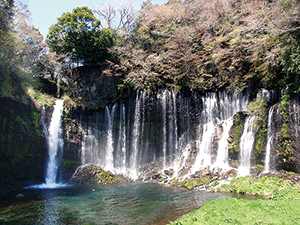
Shiraito-no-taki Falls
The lava flows from these volcanoes formed the Fuji Goko Lakes (Lake Yamanaka, Lake Kawaguchi, Lake Saiko, Lake Shoji, and Lake Motosu) and on the lava flow at the foot of the mountain on the northwest side is the Aokigahara-jukai Forest, a vast primeval forest.
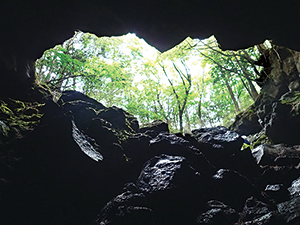
Lava Tunnel
In addition, there are many lava tunnels characteristic of volcanic regions such as wind caves, ice caves, and lava tree molds like wooden casts.
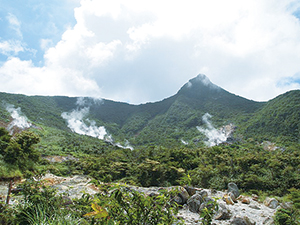
Owakudani Valley
Hakone Area
Due to the variety of volcanic landforms and volcanic ejecta that can be seen there, the Hakone Area is referred to as the Volcano Museum. Hakone Volcanos is the collective name of mountains created by repeated volcanic eruptions. Here can be seen breathtaking scenery, including Lake Ashinoko, which was formed by the blocking of a river due to the collapse of Mt. Kamiyama--the highest peak of the Hakone Volcanos--approx. 3,000 years ago, as well as Sengokuhara and Owakudani Valley, where fumarole phenomena can still be observed today. The area is also blessed with many hot springs.
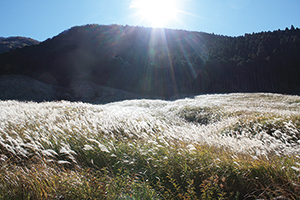
Sengokuhara Pampas Grassland
In recognition of its unique volcanic landforms, diversity of animals and plants, and distinctive culture and industry, the Hakone Area was designated as a Japanese Geopark in 2012.
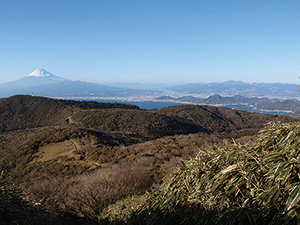
Mt. Fuji as Viewed from the Izu Mountain Ridgeline Trail
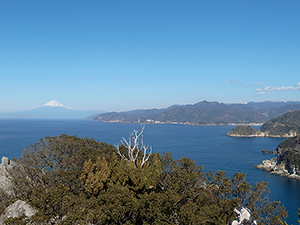
View of Sea Cliffs and Mt. Fuji
Izu Peninsula Area
The Izu Peninsula was created when volcanic islands and undersea volcanoes in the Southern Ocean moved northward on the Philippine Sea Plate, colliding with Honshu, and volcanic activity and crustal movement continues even today. The area comprises abundant hot springs, Suruga Bay--the deepest bay in Japan--a richly varying, beautiful coastline, and the gently undulating Amagi Mountain Range. Nurtured by these blessed geological resources and topographies, preservation and use of the nature and culture of the area have been recognized, and the peninsular was designated as a Japanese Geopark in 2012.
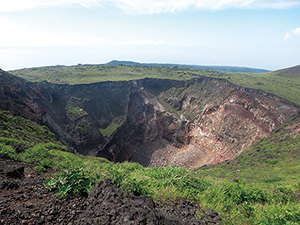
Crater of Mt. Mihara on O-shima Island
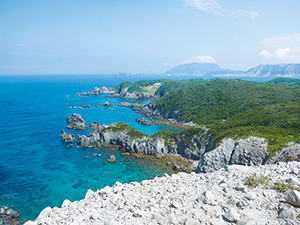
View from the Kanbiki Observatory on Shikine-jima Island
Izu Islands Area
The Izu Islands Area comprises volcanic islands located in the Pacific Ocean between 120 km and 290 km almost south of Tokyo. O-shima Island, Toshima Island, Miyake-jima Island, Mikura-jima Island, and Hachijo-jima Island mainly comprise highly fluid basaltic lava, while Niijima Island, Shikine-jima Island, Kozu-shima Island comprise highly viscous rhyolite lava, and the contrast of their white sand against the blue ocean is beautiful to behold. O-shima Island and Miyake-jima Island remain highly active volcanoes today, and various volcanic landforms created by old and new lava can be observed. Toshima Island and Mikura-jima Island are almost perfectly round volcanic islands with abundant sea cliffs, while Hachijo-jima Island was created through the coalescence of two volcanoes, and the island's distinctiveness lies in the contrast between the two.
Plants
Mt. Fuji Area
On Mt. Fuji, a typical vertical distribution can be observed, with the distribution of vegetation changing according to altitude. From the foot of the mountain to the summit, vegetation transitions from broadleaf deciduous forest through coniferous forest to volcanic desert. Because Mt. Fuji is a new volcano, another of its characteristics is the absence of creeping pine colonies.
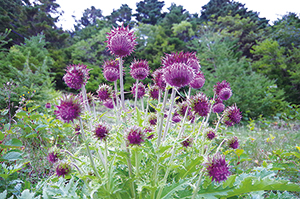
Fujiazami (Cirsium Purpuratum)
Hakone Area
In the Hakone Volcanos area remains natural forest comprising mainly deciduous broadleaf trees such as Japanese beech and Japanese zelkova. Moreover, the beauty of the four seasons can be enjoyed at the Sengokuhara Moor--which is designated as a National Natural Monument and where a diverse range of hygrophytes can be observed--and Sengokuhara Pampas Grassland covering the slopes of Mt. Daigatake. In the Hakone Area grow various plants unique to the Fuji Volcano Zone, such as Rosa nirtula and the Fuji cherry.
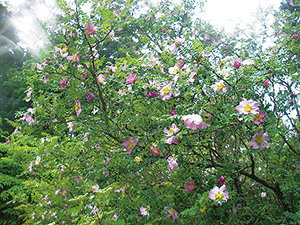
Rosa hirtula
Also, due to the popularity of biological research in the area, there are many plant species that include the word "Hakone" in their Japanese names, such as Hakonetorikabuto (Aconitum japonicum var. hakonense).
Izu Islands Area
Precious natural Japanese beech forests remain on a large scale along trails through the Amagi cordillera on the Pacific Ocean side of the peninsular, making this an important area in terms of biodiversity protection. The area has many visitors, mainly in spring--when flowers such as Rhododendron degronianum Carriere var. amagianum and Pieris japonica subsp. Japonica are in bloom--and autumn, for the beautiful crimson foliage.
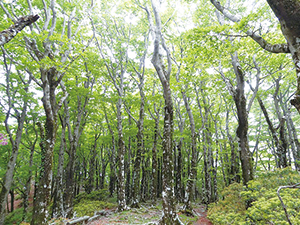
Japanese Beech Forest on the Amagi Trail
Wildlife
Mt. Fuji Area
The Mt. Fuji area is home to many wild birds--so many, in fact, that it is known as a Wild Birds' Paradise.
Hakone Area
Also, due to the popularity of biological research in the area, there are many animal that include the word "Hakone" in their Japanese names, such as Hakonesansyouo (Onychodactylus japonicus).
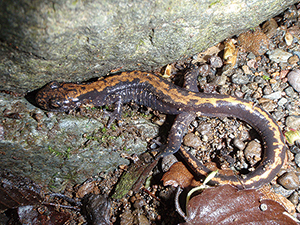
Hakonesansyouo (Onychodactylus japonicus)
Izu Islands Area
The Izu Islands are a stopping point for migratory birds, and so there is a diversity of avifauna; the islands are also home to numerous endemic species, including the Izu thrush and Ijima's leaf-warbler.In addition, Indian Ocean bottlenose dolphins live in the ocean waters around Mikura-jima Island, and dolphin watching activities are carried out in compliance with set rules.
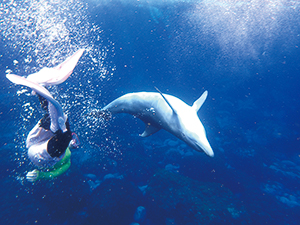
Dolphin Watching
Culture
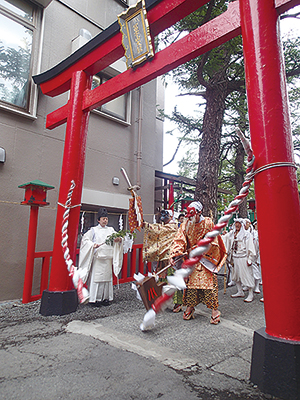
Kaizansai (Mountain Opening Festival)
Mt. Fuji Area
Revered for its beauty since ancient times, Mt. Fuji was believed to house the spirit of a deity, giving rise to Mt. Fuji worship. In the Edo period, spiritual mountain climbing (Fujiko) became popular as a pleasure trip for the common people.

Goraiko (The Sun rising behind Mt. Fuji)
Moreover, Mt. Fuji has also greatly influenced the religious beliefs and aesthetic consciousness of Japanese people as well as art culture overseas, as the subject of woodblock prints by famous artist Katsushika Hokusai such as Thirty-six Views of Mount Fuji and many other works of art. Mt. Fuji's value as an object of worship and source of art was recognized with its designation as a World Cultural Heritage Site on June 22, 2013.
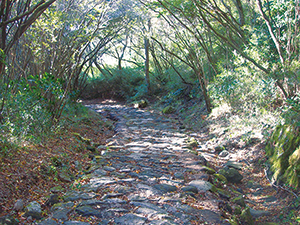
Stone Paved Road of Hakone-Hachiri
Hakone Area
As a strategic stopping point for east-west transportation, Hakone Sekisho (checking stations) were established in Hakone during the Edo period, and the town prospered as a post station on the Tokaido Road. From around this time, the Hakone Onsen (Hot Springs) were known and enjoyed popularity as Hakone-nanayu, and still attract many users as a scenic hot spring area today.
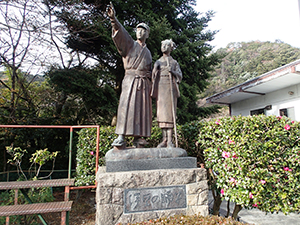
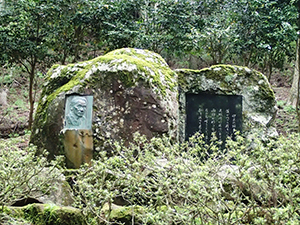
Monument to Yasunari Kawabata's The Dancing Girl of Izu
Izu Peninsula Area
During the Edo period, Izu was under the direct control of the Shogunate. Stone materials used in the stone walls of Edo Castle were quarried here. The Izu Peninsula is also the setting for literary works such as The Dancing Girl of Izu by Yasunari Kawabata and Shirobamba by Yasushi Inoue.
